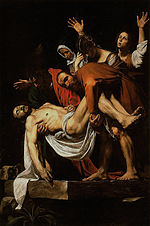
Back Hemelvaart Afrikaans Christi Himmelfahrt ALS صعود يسوع Arabic صعود يسوع ARZ Узнясенне Ісуса Хрыста Byelorussian Възнесение Господне Bulgarian যীশুর স্বর্গারোহণ Bengali/Bangla Ascensió de Jesús Catalan Nanebevstoupení Páně Czech Ανάληψη του Ιησού Greek

| Part of a series on |
| Death and Resurrection of Jesus |
|---|
 |
|
Portals: |
| Part of a series on |
| Christianity |
|---|
 |
The Ascension of Jesus (anglicized from the Vulgate Latin: ascensio Iesu, lit. 'ascent of Jesus') is the Christian belief, reflected in the major Christian creeds and confessional statements, that Jesus ascended to Heaven after his resurrection, where he was exalted as Lord and Christ,[1][2] sitting at the right hand of God.[3]
The Gospels and other New Testament writings imply resurrection and exaltation as a single event.[4][5] The ascension is "more assumed than described," and only Luke and Acts contain direct accounts of it,[6] but with different chronologies.[note 1]
In Christian art, the ascending Jesus is often shown blessing an earthly group below him, signifying the entire Church.[9] The Feast of the Ascension is celebrated on the 40th day of Easter, always a Thursday;[3] some Orthodox traditions have a different calendar up to a month later than in the Western tradition. The Lutheran Churches and the Anglican Communion continue to observe the Feast of the Ascension.[10] Certain Nonconformist churches, such as the Plymouth Brethren, do not observe the feast.[11][12]
- ^ Novakovic 2014, p. 135.
- ^ Hurtado 2005, p. 508, 591.
- ^ a b Cross & Livingstone 2005, p. 114.
- ^ a b Dunn 2009, p. 146.
- ^ Zwiep 2016, p. 145.
- ^ Holwerda 1979, p. 310-311.
- ^ Holwerda 1979, p. 310.
- ^ Dunn 2009, p. 140.
- ^ Ouspensky & Lossky 1999, p. 197.
- ^ Ascension Day. Evangelical-Lutheran Church in Denmark. 2024. Retrieved 1 April 2024.
- ^ Quast 2011, p. 45.
- ^ Stokl-Ben-Ezra 2007, p. 286.
Cite error: There are <ref group=note> tags on this page, but the references will not show without a {{reflist|group=note}} template (see the help page).